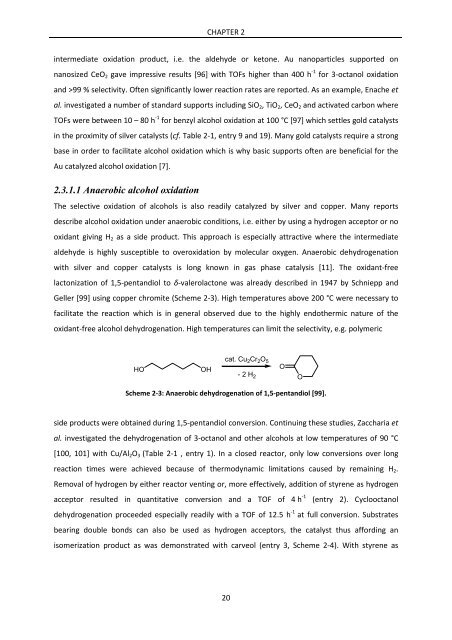Heterogeneously Catalyzed Oxidation Reactions Using ... - CHEC
Heterogeneously Catalyzed Oxidation Reactions Using ... - CHEC
Heterogeneously Catalyzed Oxidation Reactions Using ... - CHEC
You also want an ePaper? Increase the reach of your titles
YUMPU automatically turns print PDFs into web optimized ePapers that Google loves.
CHAPTER 2<br />
intermediate oxidation product, i.e. the aldehyde or ketone. Au nanoparticles supported on<br />
nanosized CeO2 gave impressive results [96] with TOFs higher than 400 h ‐1 for 3‐octanol oxidation<br />
and >99 % selectivity. Often significantly lower reaction rates are reported. As an example, Enache et<br />
al. investigated a number of standard supports including SiO2, TiO2, CeO2 and activated carbon where<br />
TOFs were between 10 – 80 h ‐1 for benzyl alcohol oxidation at 100 °C [97] which settles gold catalysts<br />
in the proximity of silver catalysts (cf. Table 2‐1, entry 9 and 19). Many gold catalysts require a strong<br />
base in order to facilitate alcohol oxidation which is why basic supports often are beneficial for the<br />
Au catalyzed alcohol oxidation [7].<br />
2.3.1.1 Anaerobic alcohol oxidation<br />
The selective oxidation of alcohols is also readily catalyzed by silver and copper. Many reports<br />
describe alcohol oxidation under anaerobic conditions, i.e. either by using a hydrogen acceptor or no<br />
oxidant giving H2 as a side product. This approach is especially attractive where the intermediate<br />
aldehyde is highly susceptible to overoxidation by molecular oxygen. Anaerobic dehydrogenation<br />
with silver and copper catalysts is long known in gas phase catalysis [11]. The oxidant‐free<br />
lactonization of 1,5‐pentandiol to δ‐valerolactone was already described in 1947 by Schniepp and<br />
Geller [99] using copper chromite (Scheme 2‐3). High temperatures above 200 °C were necessary to<br />
facilitate the reaction which is in general observed due to the highly endothermic nature of the<br />
oxidant‐free alcohol dehydrogenation. High temperatures can limit the selectivity, e.g. polymeric<br />
HO OH<br />
cat. Cu 2Cr 2O 5<br />
Scheme 2‐3: Anaerobic dehydrogenation of 1,5‐pentandiol [99].<br />
side products were obtained during 1,5‐pentandiol conversion. Continuing these studies, Zaccharia et<br />
al. investigated the dehydrogenation of 3‐octanol and other alcohols at low temperatures of 90 °C<br />
[100, 101] with Cu/Al2O3 (Table 2‐1 , entry 1). In a closed reactor, only low conversions over long<br />
reaction times were achieved because of thermodynamic limitations caused by remaining H2.<br />
Removal of hydrogen by either reactor venting or, more effectively, addition of styrene as hydrogen<br />
acceptor resulted in quantitative conversion and a TOF of 4 h ‐1 (entry 2). Cyclooctanol<br />
dehydrogenation proceeded especially readily with a TOF of 12.5 h ‐1 at full conversion. Substrates<br />
bearing double bonds can also be used as hydrogen acceptors, the catalyst thus affording an<br />
isomerization product as was demonstrated with carveol (entry 3, Scheme 2‐4). With styrene as<br />
20<br />
- 2 H 2<br />
O<br />
O



